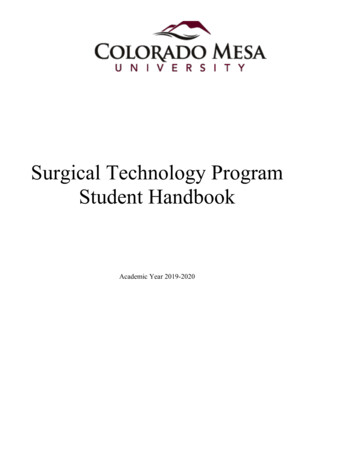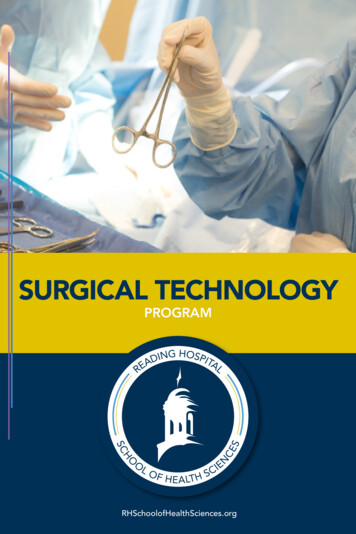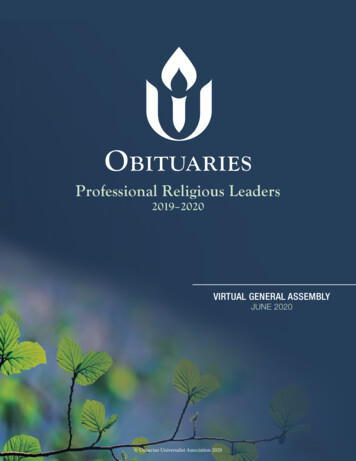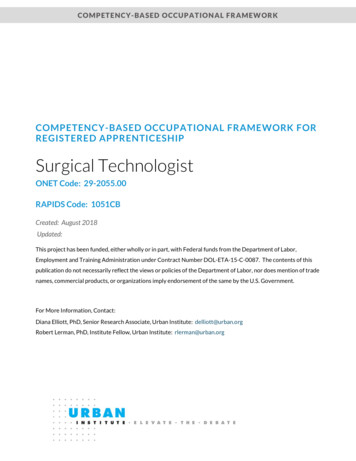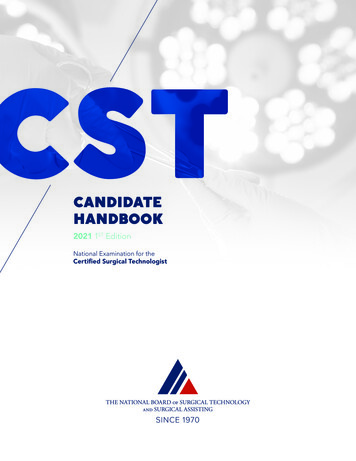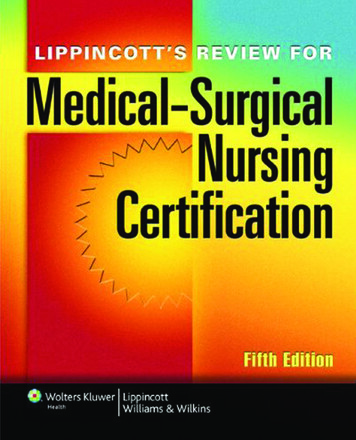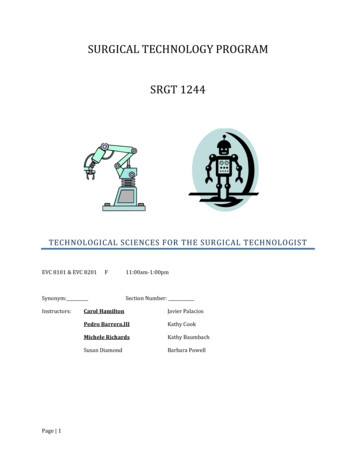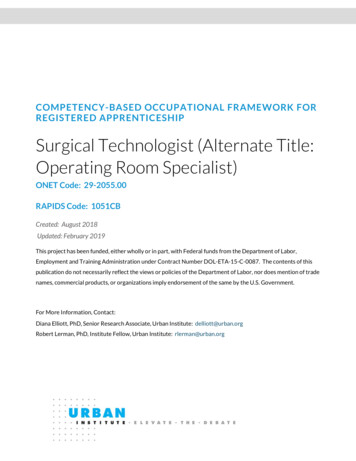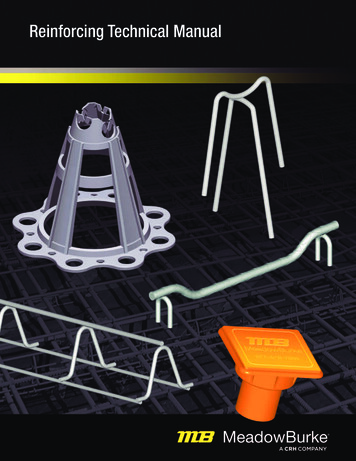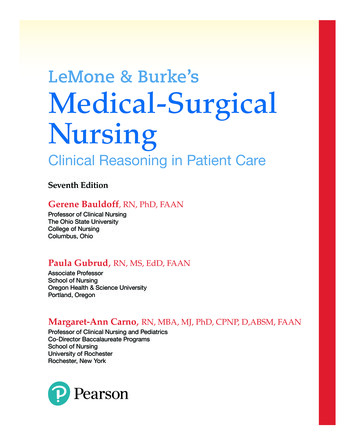
Transcription
LeMone & Burke’sMedical-SurgicalNursingClinical Reasoning in Patient CareSeventh EditionGerene Bauldoff, RN, PhD, FAANProfessor of Clinical NursingThe Ohio State UniversityCollege of NursingColumbus, OhioPaula Gubrud, RN, MS, EdD, FAANAssociate ProfessorSchool of NursingOregon Health & Science UniversityPortland, OregonMargaret-Ann Carno, RN, MBA, MJ, PhD, CPNP, D,ABSM, FAANProfessor of Clinical Nursing and PediatricsCo-Director Baccalaureate ProgramsSchool of NursingUniversity of RochesterRochester, New YorkA01 LEMO8189 07 SE FM.indd 101/12/2018 03:54
Director of Portfolio Management: Katrin BeacomExecutive Portfolio Manager: Pamela FullerDevelopment Editor: Laura S. Horowitz, YorkContent DevelopmentPortfolio Management Assistant: Erin SullivanVice President, Content Production and DigitalStudio: Paul DeLucaManaging Producer, Health Science: MelissaBasheContent Producer: Michael GiacobbeCreative Digital Lead: Mary SienerManaging Producer, Digital Studio, HealthScience: Amy PeltierDigital Studio Producer, REVEL and e-text 2.0:Ellen ViganolaDigital Content Team Lead: Brian PrybellaDigital Content Project Lead: William JohnsonVice President, Product Marketing: David GesellExecutive Field Marketing Manager: ChristopherBarryField Marketing Manager: Brittany HammondFull-Service Project Management andComposition: Pearson CSCProject Manager: Emily TamburriInventory Manager: Vatche DemirdjianInterior Design: Studio MontageCover Design: Studio MontagePrinter/Binder: LSC Communications, Inc.Cover Printer: Phoenix ColorCover: Marco Govel/ShutterstockCredits and acknowledgments borrowed from other sources and reproduced, with permission, in this textbook appear in theCredits section at the end of the book.Copyright 2020, 2015, 2011, 2008 by Pearson Education, Inc. All rights reserved. Manufactured in the United Statesof America. This publication is protected by Copyright, and permission should be obtained from the publisher prior to anyprohibited reproduction, storage in a retrieval system, or transmission in any form or by any means, electronic, mechanical,photocopying, recording, or likewise. To obtain permission(s) to use material from this work, please submit a written request toPearson Education, Inc., Permissions Department, 221 River Street, Hoboken, New Jersey 07030.Many of the designations by manufacturers and sellers to distinguish their products are claimed as trademarks. Where thosedesignations appear in this book, and the publisher was aware of a trademark claim, the designations have been printed ininitial caps or all caps.Notice: Care has been taken to confirm the accuracy of information presented in this book. The authors, editors, and thepublisher, however, cannot accept any responsibility for errors or omissions or for consequences from application of theinformation in this book and make no warranty, express or implied, with respect to its contents.The authors and publisher have exerted every effort to ensure that drug selections and dosages set forth in this text are inaccord with current recommendations and practice at time of publication. However, in view of ongoing research, changes ingovernment regulations, and the constant flow of information relating to drug therapy and drug reactions, the reader is urged tocheck the package inserts of all drugs for any change in indications of dosage and for added warnings and precautions. This isparticularly important when the recommended agent is a new and/or infrequently employed drug.Library of Congress Cataloging-in-Publication DataNames: Bauldoff, Gerene, author. Gubrud-Howe, Paula Marie, author. Carno,Margaret-Ann, author. Preceded by (work): LeMone, Priscilla.Medical-surgical nursing.Title: LeMone & Burke’s medical-surgical nursing : clinical reasoning inpatient care / Gerene Bauldoff, Paula Gubrud, Margaret-Ann Carno.Other titles: LeMone and Burke’s medical-surgical nursing Medical-surgicalnursingDescription: Seventh edition. Hoboken NJ : Pearson Education, [2020] Preceded by: Medical-surgical nursing : critical reasoning in patient care/ Priscilla LeMone, Karen Burke, Gerene Bauldoff, Paula Gubrud. Sixthedition. [2015]. Includes bibliographical references and index.Identifiers: LCCN 2018056118 ISBN 9780134868189 ISBN 0134868188Subjects: MESH: Nursing Process Nursing Care Medical-SurgicalNursing--methods Patient Care PlanningClassification: LCC RT41 NLM WY 100.1 DDC 617/.0231--dc23LC record available at https://lccn.loc.gov/2018056118ISBN-13: 978-0-134868189ISBN-10: 0-13-4868188A01 LEMO8189 07 SE FM.indd 201/12/2018 03:54
About the AuthorsGerene Bauldoff, RN, PhD, FAANGerene Bauldoff is a Professor of Clinical Nursingat The Ohio State University College of Nursing inColumbus, Ohio. She hasbeen a nurse educator for19 years, teaching medical-surgical nursing, clinical and research methodsand measurement, andevidence-based practicecourses at the baccalaureate, m aster’s, and doctoral levels. Prior to hernursing educator role, herclinical background included home health nurse, lung transplant coordinator, and pulmonary rehabilitation coordinator.Dr. Bauldoff has a diploma from the Western PennsylvaniaHospital School of Nursing in Pittsburgh, Pennsylvania, anda BSN from LaRoche College in Pittsburgh. Her graduateeducation is from the University of Pittsburgh, with a MSNin medical-surgical nursing (cardiopulmonary clinical nursespecialist) and PhD in nursing in 2001, training under LeslieHoffman, PhD, RN, FAAN.Dr. Bauldoff is an active member of multiple professional organizations including the American Academyof Nursing (AAN), Sigma Theta Tau International HonorSociety of Nursing, the American Association of Cardiovascular and Pulmonary Rehabilitation (AACVPR), theAmerican Thoracic Society Nursing Assembly, and theAmerican College of Chest Physicians (ACCP). She is arecognized expert in medical-surgical nursing, focusingon the care of the patient with chronic pulmonary disease,serving on committees focusing on international standardsfor and patient-centered outcomes in pulmonary rehabilitation. She has been honored with fellowships in AAN andACCP and is a master fellow in AACVPR. Dr. Bauldoff hasconducted several international presentations related toevidence-based practice and clinical outcomes.Dr. Bauldoff considers nursing as the greatest profession, using scientific evidence to provide the highest quality of care while maintaining the personal relationshipwith patients and their families. Her experiences provideher with insights and lessons that she shares with herstudents.Dr. Bauldoff resides in central Ohio. She enjoys international travel, walking, bicycling, golfing, and spendingtime with her family and friends.I dedicate this book to the memory of my parents, to my sisters,and to my friends, especially Vicki von Sadovszky, Linda Daley,Patty Orndoff, and Eileen Collins—you are my touchstones tothe world and are my greatest sounding boards. You help mekeep my feet on the ground and my face turned toward new opportunities. You mean the world to me!Paula Gubrud, RN, MS, EdD, FAANPaula Gubrud is Senior Associate Dean for Academic Affairs and an Associate Professor at Oregon Health and Science University (OHSU) School of Nursing. She has morethan 25 years of experience as a nurse educator involvingmultiple levels of programs from LPN to doctoral education. Dr. Gubrud is a founding leader and co-director ofthe Oregon Consortium for Nursing Education, an awardwinning consortium that includes the five campuses ofOHSU and nine community colleges. She also has morethan 20 years of experience in medical-surgical nursing,critical care, home health, and hospice. Dr. Gubrud earneda baccalaureate degree in nursing from Walla Walla University (1980), an MS in community-based nursing fromOHSU (1993), and an EdD in postsecondary educationfrom Portland State University (2008). She is a frequentinvited speaker at national and international nursing education conferences and consults with other states andcountries on the development of competency-based curriculum and nursing education consortiums designed topromote academic progression in nursing education. Herresearch activity is focused on clinical education redesignand the integration of simulation into nursing curriculum.Dr. Gubrud is passionate about nursing and the opportunities it provides members of the profession. She valuesthe sacred relationship nurses experience with patients asthey promote health, treat illness, and provide comfort andpalliative care. She believes the nation’s health depends onhighly qualified nurses who are dedicated to lifelong learning in pursuit of evidence-based, patient-centered care.Dr. Gubrud livesin the Pacific Northwest and enjoys reading, camping, hiking,and fishing. She catchesreally big salmon yearround!I dedicate this book to myhusband Leland Howeand my children ElizabethGubrud-Howe, GabrielHowe, and Caleb Howe forencouraging me to pursuemy professional passionsand goals. I also dedicatethis book to my father, A llan Gubrud, who instilled insatiable curiosity,a love of learning, and apassion to teach.iiiA01 LEMO8189 07 SE FM.indd 301/12/2018 03:54
Margaret-Ann Carno, PhD,MBA, MJ, RN, CPNP, D,ABSM,ATSF, FAANMargaret-Ann Carno is Professor of Clinical Nursing andPediatrics as well as Co-Director of Baccalaureate Programs at the University of Rochester, School of Nursing.Dr. Carno has over 20 years of teaching across baccalaureate, master’s, and doctoral levels of nursing educationin medical-surgical nursing, pediatrics, ethics, health law,sleep across the lifespan, and research. Seeing students besuccessful gives Dr. Carno the greatest joy.Dr. Carno earned her baccalaureate in nursing at Syracuse University and then went on to complete an MBA inOperations Management and an MS in Nursing (PediatricCritical Care) also from Syracuse University. She receivedher PhD from the University of Pittsburgh under the guidance of Leslie Hoffman, PhD, RN, FAAN. Dr. Carno alsoholds a Masters in Jurisprudence in Health Law from University of Loyola–Chicago and a post Masters certification as a Pediatric Nurse Practitioner from the University of Rochester, School of Nursing. She is a Fellow ofthe American Academy of Nursing and of the AmericanThoracic Society. Dr Carno is a Diplomate of the AmericanBoard of Sleep Medicine.When she is not teaching or working on other duties,Dr. Carno enjoys traveling the world with her belovedcousins as shown in the accompanying photo, where Dr.Carno is on the left.I dedicate this book to my father Joseph, who while was in mylife only a short time instilled the idea I could be anything Iwanted and to never stop learning. Also to my mom, Libera,who has been my champion and support throughout my life.ivA01 LEMO8189 07 SE FM.indd 401/12/2018 03:54
Thank YouWe wish to thank the editorial team. First and foremost, our intrepid publisher, PamelaFuller, has provided fearless leadership and a forward-thinking strategy. This book wouldnot exist without the expert editorial and organizational skills of Laura Horowitz, our development editor who brought this project to fruition with passion and graceful patience.The editorial assistance of Erin Sullivan who helped us keep all the balls in the air. We appreciate the work of Studio Montage on the cover and interior design. They brought thenew structure to life! We also wish to thank our contributors and reviewers who sharedtheir expert knowledge.Gerene BauldoffPaula GubrudMargaret-Ann CarnoContributorsMei R. Fu, PhD, RN, FAANAssociate Professor with TenureNYU Rory Meyers College of NursingNew York UniversityNew York, New York(Chapter 14)Maurade Gormley, MSN, CPNP, BSNNYU Rory Meyers College of NursingNew York UniversityNew York, New York(Chapter 14)Lynne M. Hutchinson, DNP, FNP-BCAssistant Professor of NursingUniversity of South Carolina BeaufortBluffton, South Carolina(Chapter 5)Laura Mood, PhD, MSN, BSN, RNAssistant Professor, School of Nursing,University of PortlandPerioperative Nurse, Oregon Health &Science UniversityPortland, Oregon(Chapters 2 and 4)Pam Phillips, PhD, RNAssistant ProfessorUniversity of South Carolina BeaufortHilton Head Island, South Carolina(Chapter 6)Kimberly Regis, RN, DNP, PNP-BCNationwide Children’s HospitalAmbulatory Specialty ClinicsColumbus, Ohio(Chapter 8)Matthew Sorenson, PhD, APN, ANP-C, FAANDirector, School of NursingAssociate Professor, NursingCollege of Science and HealthDePaul UniversityChicago, Illinois(Chapter 9)Betsy Swinny, RN, MSN, APRN,FNP-C, CCRNJill Volkerding, DNP, RN, CNL, CNEAssistant Professor of Clinical PracticeCollege of NursingThe Ohio State UniversityColumbus, Ohio(Chapters 43 and 44)Janice Wilcox, DNP, RNNurse Educator/Clinical InstructorJames Nursing Staff DevelopmentCollege of NursingThe Ohio State UniversityColumbus, Ohio(Chapters 12 and 13)Anita M. Zehala, MS, RN, ONC,APRN-CNS, CNEClinical Instructor of PracticeCollege of NursingThe Ohio State UniversityColumbus, Ohio(Chapters 39 and 40)Associate DirectorBaptist Health System, School ofNursingSan Antonio, Texas(Chapters 18, 19, and 20)ReviewersWanda G. Barlow, MSN, RN, FNP-BCNursing InstructorWinston Salem UniversityWinston Salem, North CarolinaHeidi L. Benavides, MSN, RNClinical Assistant ProfessorUniversity of Texas Health Science Center San AntonioSan Antonio, TexasAngie Brindowski, MSN, BSN, RNShaana Escobar, DNP, RNDeborah Ellis, RN, MSN, FNPJudith Faust, MSN, RN, CNEDepartment ChairClinical Assistant ProfessorCarroll UniversityWaukesha, WisconsinAssociate Professor of NursingMissouri Western State UniversitySt. Joseph, MissouriAssistant ProfessorDepartment of NursingArkansas Tech UniversityRussellville, ArkansasAssociate ProfessorIvy Tech Community CollegeLafayette, IndianavA01 LEMO8189 07 SE FM.indd 501/12/2018 03:54
Jacqueline Guhde, MSN, RN, CNSSenior InstructorThe University of AkronAkron, OhioAnne Harner, EdD, MSN, RNAssistant ProfessorSchool of NursingFlorida Gulf Coast UniversityFort Myers, FloridaShawna Harvey, MSN, RNDean of NursingFortis College, WestervilleNewark, OhioCatherine Howell, RN, MSNProfessor, Nursing EducationSan Diego City CollegeSan Diego, CaliforniaJamie L. Houchins, PhD, MSN, RNDean, School of NursingIvy Tech Community CollegeSellersburg, IndianaNoreen C. Kostelecky, MSN, RNPeoria, IllinoisLee Ann Leech, DEd, MSN, RN,CRNINursing InstructorEdinboro UniversityEdinboro, PennsylvaniaLynda S. Logan, MSN, RNAssistant Professor, School of NursingIvy Tech Community CollegeLafayette, IndianaHeidi Loucks, MS, RN, CNENurse EducatorCasper CollegeCasper, WyomingNaomi Lungstrom, MN, ARNP, FNPClinical Assistant ProfessorWashington State UniversitySpokane, WashingtonAndrea R. Mann, MSN, RN, CNEThird Level Chair and InstructorAria Health School of NursingTrevose, PennsylvaniaGreta I. Marek, DNP, RN, CNEAssistant ProfessorCollege of NursingEast Tennessee State UniversityJohnson City, TennesseeMary Elizabeth McKenna-Dailey,FNP-BCProfessor, Nurse EducationNorth Shore Community CollegeDanvers, MassachusettsNancy Peifer Neil, RN, BSN, MSN,PhDSonia Rudolph, RN, MSN, APRN,FNP-BCNursing Division ChairJefferson Community & TechnicalCollegeLouisville, KentuckyDonna Russo, RN, MSN, CCRN,CNENursing InstructorARIA Health School of NursingTrevose, PennsylvaniaLaree J. Schoolmeesters, PhD,RN, CNLAssociate ProfessorPresbyterian School of NursingQueens University of CharlotteCharlotte, North CarolinaMarnie Lynn Sperling, DMD,MSN, RNClinical Assistant ProfessorHenry P. Becton School of Nursing andAllied HealthFairleigh Dickinson UniversityFlorham Park, New JerseyMarianne Swihart, MEd, MSN,BSN, ASAssociate ProfessorPasco Hernando Community CollegeNew Port Richey, FloridaPalm Beach State CollegeLake Worth, FloridaviA01 LEMO8189 07 SE FM.indd 601/12/2018 03:54
PrefaceWhy We Wrote This BookDr. LeMone-Koeplin developed the original vision forMedical-Surgical Nursing: Clinical Reasoning in Patient Carebased on the belief that nursing is a holistic, evidencebased, person-centered profession. Nursing care, therefore,is provided for the whole person, not just for a malfunction of one or more body systems. We chose the cover andunit opener images to reflect this emphasis on the wholeperson.The revisions and updates reflected in the seventh edition of Medical-Surgical Nursing: Clinical Reasoning in PatientCare further reflect our belief that nurses should possess thenecessary knowledge, skills, and attitudes to continuouslyimprove the quality and safety of care in healthcare systems.We believe that nurses need to be able to use evidence-basedpractice, apply clinical reasoning skills, and understand nursing care standards to safely perform complex skills and tasks.In Unit 1, Dimensions of Medical-Surgical Nursing, Chapter 2,Health and Illness in Adults, includes a section on criticalcare with a table to easily find critical care–related topics likeshock and sepsis, burns, cardiac and pulmonary disorders, aswell as disorders of the liver/pancreas, acute kidney injury,and spinal cord injury. Unit 2, Alterations in Patterns of Health,has been revised to include a new, comprehensive chapter oncaring for the patient with alterations in sleep (Chapter 3) toemphasize the impact that inadequate sleep has on the patient in a multitude of ways.In this textbook, discussions of the human responsesto illness and disease are structured within the frameworkof clinical reasoning and the nursing process. Nursingcare is presented within the context of nursing problemsor diagnoses, emphasizing the importance of developingindividualized evidence-based plans of care. The qualityand safety implications for nursing care are addressed.Throughout the text, nursing care planning is based on aphilosophy that individuals, their families, and communities are active participants in health and illness as well asconsumers of healthcare services.Regardless of the type of healthcare service or setting,medical-surgical nurses must use knowledge and skills toprovide competent and safe patient care. The ability to effectively prioritize activities and patient care needs is critical. Nursing care is structured by the activities planned andcarried out through clinical reasoning and multiple thinking strategies when applying the nursing process. Care ofthe medical-surgical patient is based on established professional ethics and standards and is focused on promoting orreturning the patient to a state of functional health or providing palliative care at the end of life. Transitions of careare addressed for selected topics related to nursing basedon prevention, acute, chronic, and end-of-life foci.viiA01 LEMO8189 07 SE FM.indd 701/12/2018 03:54
Throughout the text, we make every effort to communicate that both nurses and patients may be male or femaleand that patients require holistic, individualized care regardless of their age, gender, or racial, cultural, or socioeconomic background. Where indicated, we addressed issuesrelated to special populations including older adults, theLGBTQI population, veterans, and adult survivors of pediatric conditions and congenital disorders. Our goal is tohelp students acquire the knowledge, resources, and competencies that ensure a solid base for clinical reasoning andthat are applied to provide safe, individualized, and competent nursing care. We use understandable language anda consistent format, focusing on the most commonly encountered conditions. We have developed multiple learning strategies to facilitate success—audio, illustrations,teaching tips, and video and animation media.Starting with the first edition, we have held fast to ourvision that this textbook: Maintains a strong focus on nursing care as the essential element in learning and doing nursing, regardlessof the gender, age, race, culture, or socioeconomic background of the patient or the setting for care. Provides a balance of pathophysiology, pharmacology,and interprofessional care to support interdependentand independent nursing interventions. Emphasizes the nurse’s role as a caregiver, educator,advocate, leader and manager, and as an essentialmember of the interprofessional healthcare team. Uses functional health patterns and the nursing processas the structure for providing nursing care in today’sworld by prioritizing nursing interventions specific toaltered responses to illness. Fosters clinical reasoning and decision making as the basisfor safe, knowledgeable, individualized clinical practice.Chapter 16Organizationof This Bookstudent learning, each chapter in the book includes keyterms, learning outcomes and clinical competencies, chapter highlights, test yourself NCLEX-type questions, and references with supporting evidence. Each chapter is groupedinto sections, and each section has a learning outcome.Each unit with a focus on altered health opens with anassessment chapter. This chapter draws on the student’s prerequisite knowledge and serves to reinforce basic principlesof anatomy and physiology as applied to assessment in bothhealth and illness. Following the assessment chapter, nursing care chapters provide information about major illnessesand traumatic injuries. Each nursing care chapter follows aconsistent format, including the following key components:Pathophysiology and Risk FactorsThe discussion of each major illness or injury begins withincidence and prevalence, risk factors, and an overview ofpathophysiology, followed by manifestations (signs andsymptoms) and complications. Selected Focus on CulturalDiversity boxes demonstrate how race, age, and gender affect differences in incidence, prevalence, and mortality.Manifestations and ComplicationsTo further describe major illnesses, manifestations including signs and symptoms, antecedents, and subsequentclinical symptoms commonly seen are described for eachcondition. Common complications are also described toprovide important information to allow anticipation of potential problems.Interprofessional CareInterprofessional care considers diagnosis and treatmentby the healthcare team. The section includes information,as appropriate, about specific tests necessary for diagnosis,medications, surgery and other treatments, fluid management, dietary management, and complementary and alternative therapies. Specific information with related nursingcare is highlighted in Medication Administration boxes andboxes focused on the nursing care of patients having a specific treatment or surgery.CareNursing Care of PatientsNursingwithWediscuss nursing assessment and care within a contextoutcomes, and intervenIntegumentary Disordersof priorities of care, diagnoses,tions, with rationales providedThe 50 chapters in this text are organized into units basedon alterations in human structure and function. To increaseChapter Outline and Learning Outcomes16.1 Common Skin Problems and Lesions 2116.5 Malignant Skin Disorders 43Describe the pathophysiology and manifestations of commonskin problems and lesions, and outline the interprofessionalcare and nursing care of patients with these disorders.Describe the risk factors for and pathophysiology andmanifestations of malignant skin disorders, and outline theinterprofessional care and nursing care of patients with thesedisorders.16.2 Infections and Infestations of the Skin 27Describe the pathophysiology and manifestations of infections and infestations of the skin, and outline the interprofessional care and nursing care of patients with these disorders.16.3 Inflammatory Disorders of the Skin 38Describe the pathophysiology and manifestations of inflammatory disorders of the skin, and outline the interprofessionalcare and nursing care of patients with these disorders.16.4 Acute Skin Disorders 4216.6 Skin Trauma 53Describe the pathophysiology and manifestations of skintrauma, and outline the interprofessional care and nursingcare of patients with these disorders.16.7 Hair and Nail Disorders 63Describe the pathophysiology and manifestations of disordersof the hair and nails, and outline the interprofessional careand nursing care of patients with these disorders.Describe the risk factors for and pathophysiology and manifestations of acute skin disorders, and outline the interprofessional care and nursing care of patients with these disorders.for each intervention. Boxesthroughout each illness discussion section present informationessential to patient care. Thesefeatures include Nursing Care ofthe Patient, Genetic Considerations,Focus on Cultural Diversity, SafetyAlerts, Multisystem Effects, Pathophysiology Illustrated, and MovingEvidence into Action.Last, for 80 major disordersor types of trauma, we providea narrative Case Study & Nursing Care Plan. Clinical reasoningviiiCLINICAL COMPETENCIES Assess functional health status of patients with integumentary disorders, and monitor, document, and report abnormal manifestations. Plan and implement evidence-based nursing interventionsA01 LEMO8189 07 SE FM.indd 8for patients with pressure injuries. Collaborate with the interprofessional team in the planning and provision of care for patients with integumentarydisorders.Implement patient teaching focused on prevention andmanagement of integumentary disorders.01/12/2018 03:54
questions specific to the care plan are provided in a section called Clinical Reasoning in Patient Care (with suggestions for decision-making provided in Appendix B underEvaluate Your Response to Clinical Reasoning in Patient Care).The nursing care section ends with information about continuity of care with essential patient and caregiver education, and suggestions for referrals and additional patientresources.Transitions of CareNew to the seventh edition, this section addresses criticalissues for patients and families along the care continuum.For identified disorders, we describe care needs relatedto prevention, acute and chronic disease, and end-of-lifeconsiderations to support planning for and implementingcomprehensive care transition.End-of-Chapter SectionsEach chapter ends with Chapter Highlights, a bulleted listof key points for each section/learning outcome; Test Yourself NCLEX-RN Review, 10 NCLEX-style review questionsthat reinforce comprehension of the chapter content (thecorrect answers with rationales are found in Appendix B);References to support all evidence presented in the chapter;and Additional Resources for students who need or want additional study.What’s New in theSeventh EditionWe are delighted to welcome Margaret-Ann Carno as acoauthor of this book. Information about Dr. Carno is included in About the Authors on page x. New features ofthe seventh edition include: A consistent chapter structure with numbered sections,a matching learning outcome for each, and a new design that emphasizes the structure, making it easier forstudents to navigate the book. Chapter 3, Nursing Care of the Patient with Alterations ofSleep, which describes commonly seen sleep disorders.The greatest strength of the chapter is that it demonstrates the linkage between sleep and health and thebidirectional nature of sleep and health. Recognizing the overwhelming number and variety ofmedications nurses must safely administer, the mostcommonly prescribed drugs are printed in blue typein the Medication Administration features. Transitions of Care replaces the section previously titledContinuity of Care. This section focuses on the nurse’sresponsibility for preparing the patient and caregiversfor transitions of care from one healthcare setting toanother or to the home.ixA01 LEMO8189 07 SE FM.indd 901/12/2018 03:54
Chapter Features15.2 Assessing the Integumentary SystemAssessment Addressing the first stepin the nursing process, the assessmentfeature provides a review of the objectiveand subjective data needed to providea clear clinical picture of the condition.Techniques and normal findings arecompared to abnormal findings. Selectedassessments include detailed guidelinesfor psychomotor skills used to assess the106Chaptersystem.18 Assessing the Endocrine Systemorgan11Integumentary AssessmentsTechnique and NormalFindings (in italics)Abnormal FindingsInspect skin color and note any odorscoming from the skin.Skin color should be even, appropriate to theage and race of the patient, without foul odors. Inspect the skin for lesions and alterations,including calluses, scars, tattoos, andpiercings. Include inspection of skincreases and folds.Skin should be intact without lesions. A strong odor of perspiration may indicate poor hygiene and a need for patient teaching. A foul odormay indicate a disorder of the sweat glands.Pallor and/or cyanosis are seen with exposure to cold and with decreased perfusion and oxygenation.In cyanotic dark-skinned patients, skin loses glow and appears dull. Cyanosis may be more visible inthe mucous membranes and nail beds of these patients. In dark-skinned patients, jaundice may be most apparent in the sclerae of the eyes. Redness, swelling, and pain are seen with various rashes, inflammations, infections, and burns. Firstdegree (superficial) burns cause areas of painful erythema and swelling. Red, painful blisters appearin second-degree (partial-thickness) burns, whereas white or blackened areas are common in thirddegree (full-thickness) burns. Vitiligo, an abnormal loss of melanin in patches, typically occurs over the face, hands, or groin. Vitiligois thought to be an autoimmune disorder. Diagnostic TestsPrimary, secondary, and vascular lesions are described and shown in Tables 15.4 through 15.6.Pearly edged nodules with a central ulcer are seen in basal cell carcinoma.Scaly, red, fast-growing papules are seen in squamous cell carcinoma.Dark, asymmetric, multicolored patches (sometimes moles) with irregular edges appear in malignantmelanoma.Circular lesions are usually present in ringworm and in tinea versicolor.Grouped vesicles may be seen in contact dermatitis.Linear lesions appear in poison ivy and herpes zoster.Urticaria (hives) appears
Pediatrics as well as Co-Director of Baccalaureate Pro-grams at the University of Rochester, School of Nursing. Dr. Carno has over 20 years of teaching across baccalau-reate, master’s, and doctoral levels of nursing education in medical-surgical nursing, pediatrics, ethics, health law, sl
